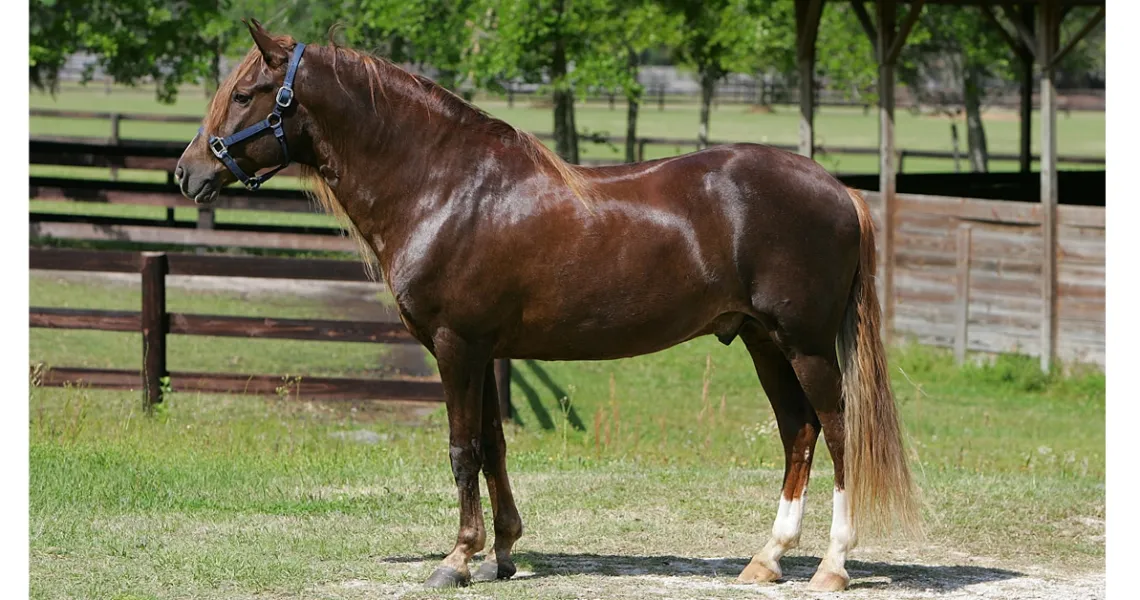The Peruvian Paso is a horse breed that originated in Peru.
They are known for their smooth gaits and are used for dressage, parade, and pleasure riding.
If you’re thinking of getting a Peruvian Paso, here’s everything you need to know about these beautiful horses!
Peruvian Paso Breed Info
Here are some of the key things you need to know about the Peruvian Paso:
| Height (size) | 14.0 – 15.0 hands high |
| Colors | Chestnuts, bay, and dun, black, buckskin, palomino, grey and roan; white markings on the face and legs are permitted |
| Country of Origin | Peru |
| Common Uses | Pleasure and trail riding, showing, cattle work, endurance riding, parades |
Peruvian Paso Facts & Information (Breed Profile)
The modern Peruvian Paso is the result of four centuries of systematic breeding in the harsh climate of Peru.
The vast ranches established by the Spanish in South America relied on imported European horses for transportation and work.
Strong, dependable animals that were both comfortable to ride and simple to handle were essential to colonial life.
However, in the past, smoothness under saddle was the most significant characteristic of the breed for riders working on great ranchos and haciendas, and that characteristic has remained the trademark of the Peruvian Paso in modern times as well.
Over time, Peruvian studs selectively bred for the paso llano gait, conformation and temperament.
The Peruvian Paso today is hardy and has lots of stamina because it was bred for centuries to be able to endure the harsh terrain of Peru consisting of both mountains and the desert.
Since 1992, the breed has been under the protection of the Peruvian government, and it has been rightfully declared part of the Cultural Heritage of the Nation.
Thanks to their wonderful temperament and smooth gaits, these horses have gained worldwide popularity.
The name for the Peruvian Paso, comes from the Spanish word paso meaning ‘step’.
The Peruvian Paso is sometimes confused with another horse of Spanish ancestry, the Paso Fino from Puerto Rico.
If you’re interested in learning more about this fascinating breed, keep reading!
Alternative Names
n/a
Temperament/Personality
Energetic, willing, responsive
Physical Characteristics
The head is of medium size with a straight or somewhat convex profile.
The neck is short and muscular and carried upright.
The chest is deep.
The back is wide, and the croup is round, with a low-set tail.
The legs are refined with flexible joints, and the hooves are strong.
Their distinguishing feature are their exceptionally smooth gaits.
Their natural four-beat lateral gait is called the paso llano.
Peruvian Paso foals may be seen gaiting next to their moms within a few hours after birth.
The Peruvian Paso doesn’t trot.
The paso llano is excellent for traveling great distances in a relatively short amount of time without wearing out either the horse or the rider.
Another distinguishing characteristic of the breed’s gait is the termino, a flashy outward swinging action of the front legs during their forward stride.
The quicker gait is called sobreandando, and speed wise can replace canter while riding. Performing a sobreandando at higher speeds on a Peruvian Paso is just as fast as cantering, but it requires less effort from the rider and is less tiring for the horse.
One of the defining characteristics of the breed is brio which roughly translates as ‘willing energy’.
Colors
Chestnuts, bay, and dun, black, buckskin, palomino, grey and roan; white markings on the face and legs are permitted
Height (size)
14.0 – 15.0 hands high
Stallions
n/a
Mares
n/a
Weight
900 – 1,100 lbs (400 – 500 kg)
Blood Type
Warm
Common Uses
Pleasure and trail riding, showing, cattle work, endurance riding, parades
Health
n/a
Popular Traits
Its distinctive gait called paso llano
Feeding/Diet
n/a
Country of Origin
Peru
Ancestors
Spanish colonial horses – Andalusian, Barb, Spanish Jennet
